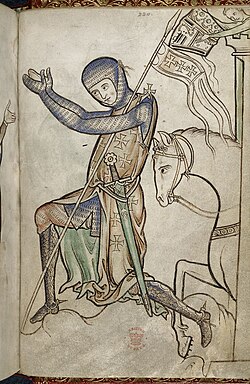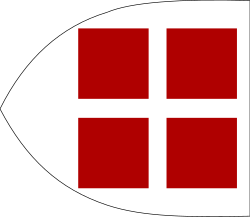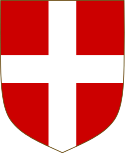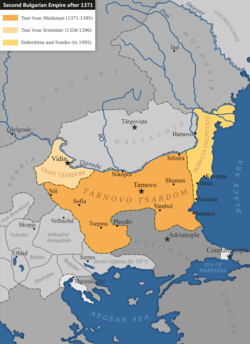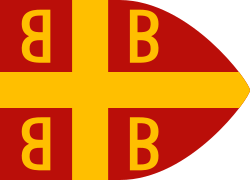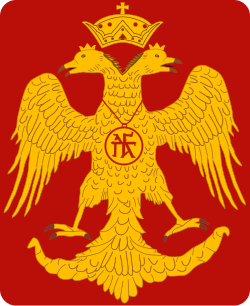Savojská křížová výprava
| Savojská křížová výprava | |||
|---|---|---|---|
| konflikt: Křížové výpravy, byzantsko-bulharské a byzantsko-osmanské války, osmanská expanze | |||
 Savojští křižáci na fresce v biskupském paláci v Colle Val d'Elsa | |||
| Trvání | 1366–1367 | ||
| Místo | Bulharsko, Gallipoli a Konstantinopol | ||
| Výsledek | dobytí Gallipoli a bulharského pobřeží | ||
| Změny území | dobyté území vráceno Byzantské říši | ||
| Strany | |||
| Velitelé | |||
| |||
| Síla | |||
| |||
| Některá data mohou pocházet z datové položky. | |||
Savojská křížová výprava v roce 1366 byla jednou z pozdních nábožensky motivovaných válečných tažení proti muslimům. K její realizaci došlo z iniciativy papeže Urbana V. a na základě stejného plánu, do něhož spadala také alexandrijská křížová výprava podniknutá o rok dříve. Na rozdíl od ní byla tato namířena proti Osmanské říši expandující na Balkáně. Křížové výpravě, jíž velel savojský hrabě Amadeus VI. ve spolupráci s Uhrami a Byzancí, se podařilo dobýt na Osmanských Turcích město Gallipoli. Po tomto úspěchu sešlo od původního záměru bojovat s muslimskými Turky a výprava se obrátila proti Bulharské říši na severu. Křižácká flotila přeplula Bosporskou úžinu a vplula do Černého moře, odkud přepadávala přístavní města na bulharském pobřeží. Nevelká dobytá území křižáci přenechali upadající Byzantské říši, která se na výpravě rovněž podílela.
Mapy
- Tažení křižáků proti Bulharsku
- Bulharská říše v době kruciáty
Reference
V tomto článku byl použit překlad textu z článku Savoyard crusade na anglické Wikipedii.
Média použitá na této stránce
Red_St_George's_Cross
Used by Archbishopric-Electorate of Trier 898–1794 (Erzbistum Trier)
Vatican flag before1808
According to Rıza Nur, sultan Selim I (1512-20) had a white personal flag, while the Ottoman Army flag was red (kızıl bayrak). During Süleyman I's reign (1520-66) the janissaries had a white flag while the timariot cavalry had a red flag. It was used as the Ottoman civic and merchant flag from 1793 to 1923.
A kneeling knight with his horse before setting off on the crusades. His servant leaning over the turret with his masters helmet.From the Westminster Psalter, BL Royal MS 2 A xxii f. 220
Flag of Vicina, Dobrudja, around 1350, according to the story of a Spanish Franciscan friar:
- I left Constantinople and entered the Mare Mayor (Black Sea), proceeding along the coast of the left hand to a great city called Vecina (Vicina¹). Here nine rivers unite and fall into the Mare Mayor². These nine rivers make a great commotion before this city of Vecina, which is the capital of the kingdom³. It has a white flag with four red squares.
² - The Danube Delta.
³ - Possible refference to principality of Dobrotici of Dobrudja.
Autor: Samhanin, Licence: CC0
Flag of the Second Bulgarian Empire (Ivan Shishman of Bulgaria Era, 1380). as shown in the Guillem Soler.
“Detail of a fresco on the walls of a hall in the bishop's palace at Colle Val d'Elsa. Under the knight on the left appears the legend: "C di Savoi" [not visible]. The fresco portrays the departure of barons on a crusade and some of their exploits against the infidel. The artist is unknown, but the fresco is usually ascribed to the Sienese school and dated in the last half of the fourteenth century. Photograph by Grassi, Siena.” Description from: Cox, Eugene L. (1967). The Green Count of Savoy: Amadeus VI and Transalpine Savoy in the Fourteenth Century. Princeton, New Jersey: Princeton University Press, p. xv.
The coat of arms of Louis I of Hungary (1364)
Autor:
Quarterly Jerusalem and Lusignan.
Autor:
- derivative work: Fry1989
Shield of the coat of arms of the Kingdom of Italy and of the Royal House of Savoy.
Autor: Пакко, Licence: CC BY-SA 3.0
Coat of Arms or emblem of Tsar Ivan Shishman, tsar of the Second Bulgarian Empire during 1371–1395. The image is based on the original miniature from the second half of the 14th century by an anonymous Arab traveller, now in the King's Archive of Morocco.
Autor: Bichoes78, Licence: CC BY-SA 4.0
герб на домът на Гатилузо, генуезка благородническа фамилия, управлявала остров Лесбос
Military campaign of Amadeus VI against Bulgaria (1366-67)
Second Bulgarian Empire after 1371
Autor: Ddurbmonnejg, Licence: CC BY-SA 4.0
Naval and land fortifications flag of the Republic of Venice (XIV century)
Flag of Hungary from 1301 untill 1382.
Flag of Genoa
Autor: Saltspan, elements by Sodacan, Licence: CC BY-SA 4.0
Arms of the kings of France (France Ancien)
State Flag of the Savoyard States (late 16th - late 18th century).
Autor: Cplakidas, Licence: CC BY-SA 3.0
The Byzantine imperial ensign (βασιλικόν φλάμουλον), as depicted in the 14th-century Castilian Book of All Kingdoms, and described in the Treatise on Offices by the mid 14th-century Byzantine writer Pseudo-Kodinos as being hoisted on imperial naval vessels. It features the tetragrammic cross with the four "B"s that is attested in contemporary portolans, on coins and reliefs.
Autor: Facquis, Licence: CC BY-SA 4.0
Bandiera della Signoria di Milano
(c) Goran tek-en, CC BY-SA 4.0
The Byzantine double-headed eagle with the sympilema (the family cypher) of the Palaiologos dynasty.






